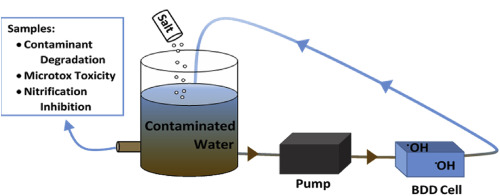Chemosphere ( IF 8.8 ) Pub Date : 2018-01-06 , DOI: 10.1016/j.chemosphere.2018.01.007 Rebecca B Phillips 1 , Ryan R James 2 , Matthew L Magnuson 3

|
Intentional and unintentional contamination incidents, such as terrorist attacks, natural disasters, and accidental spills, can result in large volumes of contaminated water. These waters may require pre-treatment before disposal and assurances that treated waters will not adversely impact biological processes at wastewater treatment facilities, or receiving waters. Based on recommendations of an industrial workgroup, this study addresses such concerns by studying electrochemical advanced oxidation process (EAOP) pre-treatment for contaminated waters, using a boron-doped diamond (BDD) anode, prior to discharge to wastewater treatment facilities. Reaction conditions were investigated, and microbial toxicity was assessed using the Microtox® toxicity assay and the Nitrification Inhibition test. A range of contaminants were studied including herbicides, pesticides, pharmaceuticals and flame retardants. Resulting toxicities varied with supporting electrolyte from 5% to 92%, often increasing, indicating that microbial toxicity, in addition to parent compound degradation, should be monitored during treatment. These toxicity results are particularly novel because they systematically compare the microbial toxicity effects of a variety of supporting electrolytes, indicating some electrolytes may not be appropriate in certain applications. Further, these results are the first known report of the use of the Nitrification Inhibition test for this application. Overall, these results systematically demonstrate that anodic oxidation using the BDD anode is useful for addressing water contaminated with refractory organic contaminants, while minimizing impacts to wastewater plants or receiving waters accepting EAOP-treated effluent. The results of this study indicate nitrate can be a suitable electrolyte for incident response and, more importantly, serve as a baseline for site specific EAOP usage.
中文翻译:

使用掺硼金刚石阳极的电化学氧化水处理的电解质选择和微生物毒性,以支持特定位置的污染事件响应。
有意和无意的污染事件,例如恐怖袭击,自然灾害和意外溢出,都可能导致大量的水污染。这些水在处置前可能需要进行预处理,并确保处理后的水不会对废水处理设施或接收水的生物过程产生不利影响。根据一个工业工作组的建议,本研究通过在排放到废水处理设施之前使用掺硼金刚石(BDD)阳极研究了用于污染水的电化学高级氧化工艺(EAOP)预处理,从而解决了这些问题。反应条件进行了调查,和微生物的毒性是使用了Microtox评估®毒性测定和硝化抑制试验。研究了一系列污染物,包括除草剂,农药,药物和阻燃剂。所产生的毒性随辅助电解质的变化从5%到92%不等,并且经常增加,这表明在处理过程中,除母体化合物降解外,还应监测微生物的毒性。这些毒性结果特别新颖,因为它们系统地比较了多种支持电解质的微生物毒性作用,表明某些电解质可能不适用于某些应用。此外,这些结果是首次将硝化抑制测试用于此应用的已知报告。全面的,这些结果系统地证明,使用BDD阳极进行阳极氧化可用于处理被难处理的有机污染物污染的水,同时最大程度地减少对废水处理厂或接受EAOP处理的废水的影响。这项研究的结果表明硝酸盐可能是一种适合事件响应的电解质,更重要的是,它可以用作特定地点EAOP使用的基准。



























 京公网安备 11010802027423号
京公网安备 11010802027423号